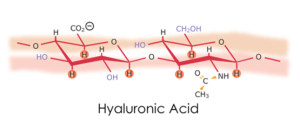What is Hyaluronic Acid?
Hyaluronic acid (HA) is a gel-like water holding molecule that is the space filler and cushioning agent in all mammals. HA cushions joints, nerves, hydrates skin and hair, and fills the eye. Although originally discovered in 1934 by Karl Meyer, HA gained momentum only after a visit by a reporter to a Japanese village of Yuzuri Hara to find out why both men and women in their 80’s and 90’s had smooth wrinkle free skin, flexible joints, full heads of hair and activity levels that defied their age. This was eventually found to be related to oestrogen-like molecules in their diet from soya and tofu, which sent signals to the cells to make more hyaluronic acid.
Our bodies roughly contain 15 grams of HA and it is found in virtually every part of the body. With such a widespread occurrence, it is logical that HA also has multiple functions. Scientific studies have shown that HA improves skin hydration, stimulates production of collagen in skin, works as an antioxidant and free radical scavenger, maintains skin elasticity, cushions joints and nerve tissues, has an antibacterial and anti-inflammatory activity and maintains the fluid in the eye tissues, which may help to protect against numerous possible eye concerns.
The average human body contains roughly 15 grams of HA, one third of which is degraded and synthesized on a daily basis. This is where the problems arise! The manufacture of every single protective agent in the body declines with age and HA is no exception to this rule. Decreasing levels of hyaluronic acid are known to accompany the ageing process and it is estimated that by the time we reach our mid-40’s, the synthesis of HA is roughly half that required by the body.
Benefits of Hyaluronic Acid
Skin: Almost half of the body’s HA is located in the collagen of skin and it is logical that HA plays a vital role here. Hyaluronic acid helps to retain over a 1000 times its weight in water within the cells of skin, making it an excellent moisturizer. In fact, no other biological substance can retain as much water as HA resulting in increased smoothness, softening and decreased wrinkles. Equally important is its ability to remove waste matter from cells including those where there is little blood circulation.
Today, hyaluronic acid is considered equally important, if not more important, than Collagen. The most common application for hyaluronic acid is in anti-ageing therapy, particularly with cosmetic procedures such as the elimination of skin imperfections and wrinkles, but these are not without problems and since HA is destroyed by the body, they need to be repeated regularly and are often expensive.
Joints: Most of us have heard of glucosamine supplements used for the treatment of arthritic conditions. Glucosamine belongs to a group of compounds known as glycosaminoglycans (GAGs). These compounds help you build stronger, healthier and more flexible joints. Hyaluronic acid is the most active form of GAG’s and it works as a shock absorber lubricating the fluid in the joint tissues as well as stabilising its breakdown. It also works to remove the waste products, often acidic in nature, that arise from the destruction of the cartilage matrix and hence eases joint pain. As an antioxidant, it further supports joint health by protecting joint destruction due to free radicals. Hyaluronic acid can be administered by way of injections directly into the knees, although treatment can be very expensive and often needs to be repeated due to its natural breakdown.
Eyes: Hyaluronic acid is found in the vitreous fluid in the eyes and gives them their shape and characteristics. The first hyaluronic acid medical product was intended for use in eye surgery specifically for cataract surgery and glaucoma and was used to hasten the healing process following surgery. Since hyaluronic acid lubricates the eye tissues, it is of great benefit for people suffering from dry eyes. Oral supplements of HA may also help your eyesight. The reason for this is that as we age, less HA is found in the eye tissues and it is required to help support the eye structures.
Gum Disease: Gum disease is a common problem in the UK affecting 3 out of 4 adults over the age of 35. Gum disease, and not tooth decay, is the single biggest cause of tooth loss. Hyaluronic acid is an important connective tissue component in the gums helping with the regeneration of fresh healthy gum tissue as well as reducing any inflammation that leads to bleeding gums. Several studies indicate that applying hyaluronic acid as a gel (Gengigel) helps to reduce bleeding gums and other indicators of gum disease.
There are many additional benefits reported with the use of hyaluronic acid and these include faster wound healing, increased energy, dry skin relief, improved muscular strength and increased mental alertness.




